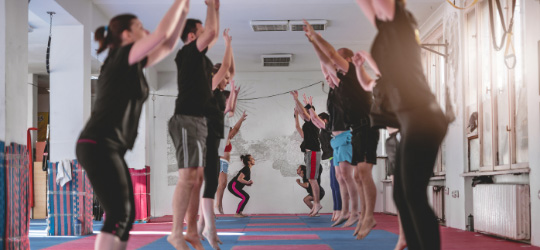You don’t have to be an athlete to want to increase your power.
Even if you aren’t training for performance, there are a range of benefits from tapping into your nervous system to fire as many muscle fibers as possible.
Being able to do this is one of the key drivers of generating explosive power and it only comes through training.
Although there are many different types of training that can help you develop this ability, interval training has traditionally not been one of them.
The reason is because the way most people do interval training quickly leads to fatigue. For a lot of people, fatigue is a measuring stick of whether or not the intervals are effective in the first place.
The problem with this is that at the simplest level, fatigue is the opposite of power.

Power comes contracting as many muscle fibers as possible, at all once, in a synchronized manner. It’s driven largely by the anaerobic energy systems.
Fatigue, on the hand, is what happens when your biggest, strongest, and most powerful muscle fibers stop contracting.
That’s the reason you slow down and your power output decreases in the first place. You have fewer muscle fibers firing.
That’s not a recipe for becoming more powerful.
How do power intervals work
There are two different types of power intervals, green power intervals and red power intervals, but they both work in the same way.
Unlike a lot of other interval methods, they use a work period that’s much shorter than the rest period.
The goal is not to become fatigued. It’s to be as explosive as possible in each and every rep. This requires more rest and less work than most people are used to when they do intervals.
This is the only way to tap into your entire range of muscle fibers and train both your nervous system and your energy systems in the process.
The other key to power intervals is to focus on the rest period itself. Rather than passive recovery, where you just sit there and wait to go again, power intervals use active recovery.
This helps speed up your recovery in between reps and maintain your power more effectively.
Green Power intervals
Green power intervals are designed to help develop your top end power output. This is driven by what’s called the anaerobic-alactic energy system.
This is your most explosive system, but it’s also the most limited. It can only produce maximum power for a few seconds at a time before it starts to rapidly decline.

Because of this, you’ll want to keep the work period to between about 5-10 seconds. The key is that these few seconds need to be at 100% intensity.
If you go anything less than maximum, you won’t tap into the top end muscle fibers that only come into play when you really need them.
As long as you’re doing this, you should see your heart rate spike up into the green during each of the work periods of the interval.
As soon as each 5-10 seconds of max power is over, try to drive your heart rate back down to the middle of the blue zone as fast as possible to start your period of active rest.
During this phase, you can do a variety of things, ranging from a slow jog to jumping on the bike, jumping rope, etc. The most important thing is just being active to keep your blood flow up and speed up recovery between reps.
The middle of the blue zone is where you should get to and stay for a total active rest period of about 40-60s before doing another rep.
Anywhere from 5-12 reps is the recommended range of green power intervals.

Red Power intervals
Red power intervals use the same principles as green power intervals, the main difference is that they are focused more on developing the anaerobic-lactic energy system.
This means they are a bit longer, around 20-30 seconds during the work period, and 2-3 minutes in the middle of blue during the active recovery phase.
Because you’ll be going at 100% during the work period, you should expect to get up into your red zone.
Although these are challenging intervals because of this, the 2-3 minutes of active rest is designed to prevent you from becoming fatigued to the point that you start significantly slowing down with each rep.
If you feel this happening, increase the rest interval. Remember, fatigue may be a byproduct of training at high intensity, but it is not the goal of it.
You can start with as few as 2-3 reps of red power intervals and work up to as many as 5-8 over time.
What kind of exercises should you use?
Many different types of exercises can be used for both green and red power intervals. The best ones are total body exercises like sprinting because they use the most muscle.
Various pieces of cardio equipment like the Versaclimber or Jacob’s Ladder also provide a great low-impact solution as well.
If none of those are an option, you can do explosive bodyweight exercises like squat jumps, burpees, etc.

If you choose to use strength training exercises, make sure to use ones that generally do not require a very high level of technical proficiency to do correctly and safely.
Doing a technically demanding lift at 100% intensity for up to 20-30s seconds is a good way to develop bad movement patterns and increase the risk of injury.
If you’re an athlete, sport-specific drills can be used effectively as well.
How often should you do them?
Both green and red power intervals should be included between 1-2 times per week when improving your power is the goal.
Because of their high intensity and the need to go at 100% to get the most out of them, they are most suited for your red workouts.
Although there are exceptions, it’s generally more effective to include either green or red power intervals within a training program, not both. This helps keep your focus on improving one specific area of fitness at a time and is likely to lead to the best results.
When you first start incorporating these types of higher intensity intervals into your program, it’s common to see a drop in HRV during the first 1-2 weeks. As long as you’re allowing yourself to recover, you should then see a rebound in the following weeks.
